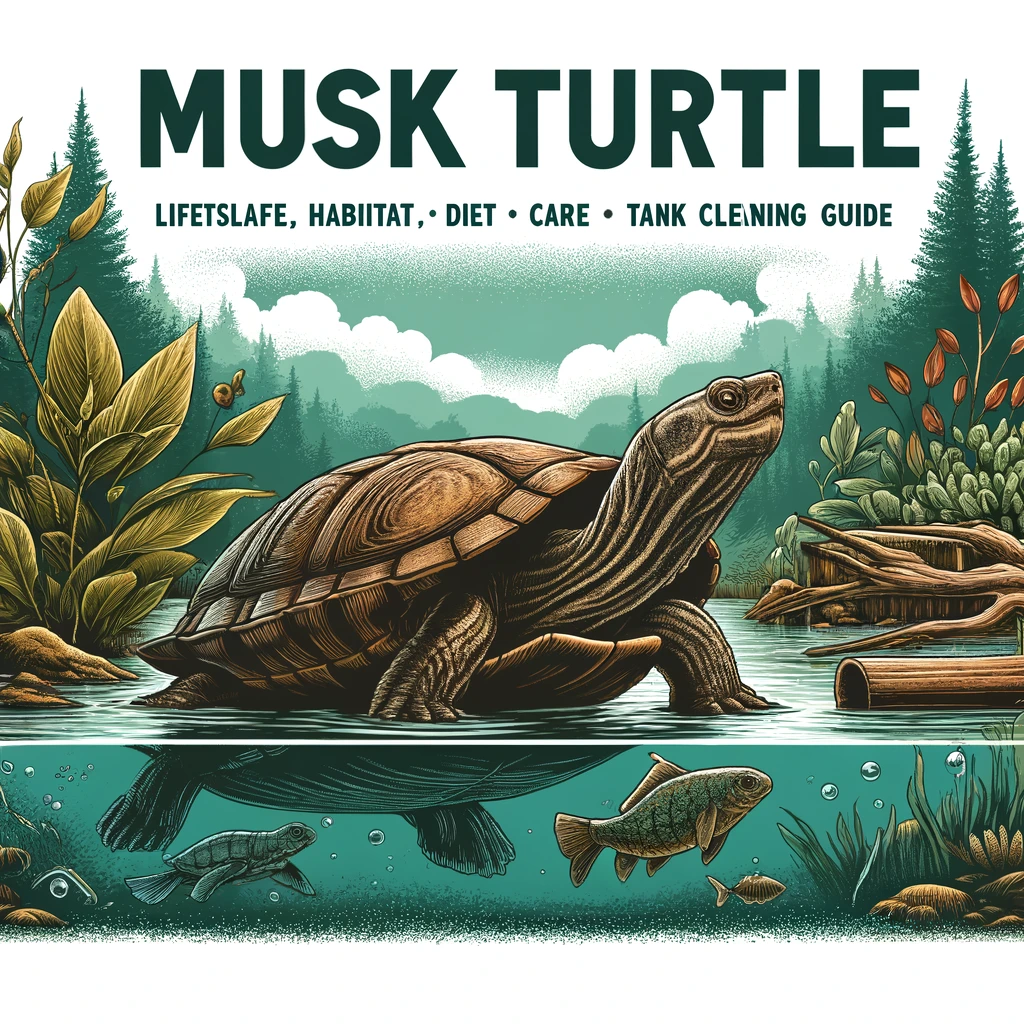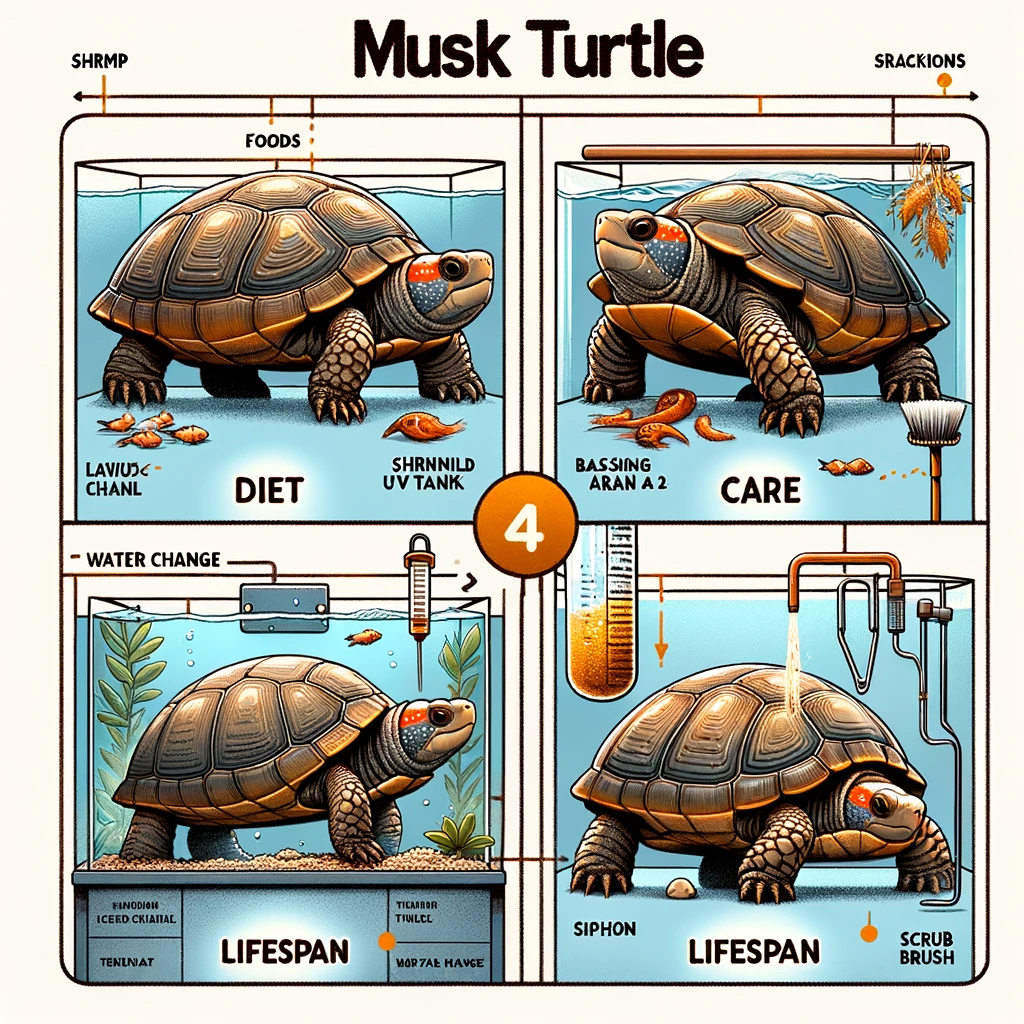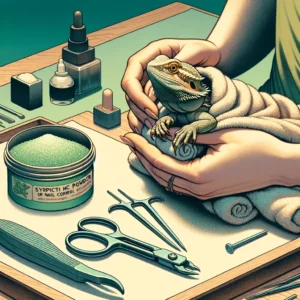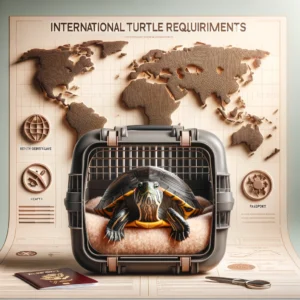Musk turtles, often known as “stinkpots” due to their ability to release a foul odor from their musk glands when threatened, are a popular choice for turtle enthusiasts. They are particularly favored due to their small size and relatively simple care requirements. This detailed guide will cover the essential aspects of caring for Musk turtles, including their lifespan, natural habitat, diet, general care, and tank maintenance.

Lifespan
Average Lifespan:
- In Captivity: Musk turtles can live for up to 50 years when properly cared for, although a more common lifespan is around 30 to 40 years.
- In the Wild: Their lifespan tends to be shorter due to predation and environmental factors.
Natural Habitat
Musk turtles are native to North America, thriving in a range of slow-moving freshwater environments:
- Preferred Habitats: They are commonly found in ponds, marshes, and slow streams where there is plenty of aquatic vegetation.
- Behavioral Traits: These turtles spend much of their time in the water but will occasionally bask on logs or rocks. They are predominantly nocturnal.
Diet
The diet of Musk turtles in the wild differs somewhat from what is recommended in captivity:
Natural Diet in the Wild
In their natural habitat, Musk turtles have a carnivorous diet that includes a variety of protein sources and occasional plant matter:
- Animal Protein:
- Insects: Such as water beetles, snails, and larvae.
- Fish: Small fish and fish carcasses, which provide essential fatty acids and protein.
- Carrion: Dead animals, which although not glamorous, is a natural part of many aquatic turtles’ diets.
- Crustaceans: Small crayfish and other aquatic crustaceans.
- Plant Matter:
- Aquatic Vegetation: While not a large part of their diet, they will occasionally eat algae and soft aquatic plants.
Recommended Diet in Captivity
To mimic their natural diet and fulfill their nutritional needs, a specific diet should be followed in captivity:
Core Diet Components
- Commercial Turtle Pellets: These should form the bulk of their diet (about 75%). Choose high-quality pellets fortified with vitamins and minerals to support their health.
- Animal Proteins:
- Shrimp: Freeze-dried shrimp or krill are great for protein and are usually eagerly eaten.
- Fish: Offering small, live or frozen fish like minnows or guppies provides nutrient variety and mental stimulation.
- Insects: Feeder insects such as bloodworms, earthworms, or mealworms can be given as treats or part of regular meals.
Occasional Supplements
- Vegetables: Offer small amounts of finely chopped aquatic plants or terrestrial vegetables like lettuce, kale, or carrot tops. These should not form more than 5-10% of their diet.
- Fruits: Occasionally, small portions of fruit such as apples or melons can be offered, but these should be limited due to high sugar content and not all turtles will eat fruit.
Feeding Schedule
- Juveniles: Musk turtle hatchlings and juveniles should be fed daily. Their rapid growth requires consistent intake of high protein and calcium for healthy shell and body development.
- Adults: Reduce feeding to every other day as they reach adulthood to prevent obesity. Adult Musk turtles require a balanced diet with a focus on maintaining health rather than growth.
Special Dietary Considerations
- Calcium and Vitamin Supplements: Especially important if your water does not naturally contain these minerals. A calcium block can be placed in the tank, or food items can be dusted with a calcium supplement periodically.
- Variety is Key: Regular changes in the diet not only prevent nutritional deficiencies but also keep the turtle engaged and interested in its food.
Practical Feeding Tips
- Avoid Overfeeding: This can lead to health problems such as shell deformities and liver issues. Watch your turtle’s growth and adjust food amounts as necessary.
- Monitor Food Intake: Especially when introducing new foods. Some turtles may be picky eaters, so it may take some experimentation to find the right mix they will eat.
Care Requirements
Proper care is crucial for keeping Musk turtles healthy. Here are the fundamental requirements:
- Tank Size: A 20 to 40-gallon tank is adequate for one Musk turtle. If adding more turtles, increase the tank size proportionally.
- Water Temperature: Should be kept between 72°F and 78°F.
- Basking Area: Though they rarely bask, providing a basking spot with a temperature of around 85°F is recommended.
- UVB Lighting: Essential for Vitamin D synthesis and overall health; should be on for 10-12 hours per day.
- Filtration: A strong filter (canister filters are preferred) is necessary to keep the water clean.

Tank Cleaning
Maintaining a clean tank is vital to prevent disease and keep your turtle healthy. Here’s how to do it:
Weekly Maintenance:
- Water Testing: Check levels of ammonia, nitrite, nitrate, and pH.
- Partial Water Change: Replace 25% of the tank water with fresh, dechlorinated water.
Monthly Maintenance:
- Full Tank Clean:
- Remove all water and clean the substrate and decorations.
- Scrub the tank walls with a clean, algae-free cloth.
- Rinse everything thoroughly before reassembling the tank.
As Needed:
- Filter Maintenance: Clean or replace the filter media as directed by the manufacturer, usually once a month.
- Health Checks: Regularly observe your turtle for signs of illness, such as lethargy, loss of appetite, or visible sores.
Summary Table
Here’s a quick reference table for the care and maintenance of Musk turtles:
| Aspect | Detail |
|---|---|
| Lifespan | Up to 50 years in captivity |
| Habitat | Slow-moving freshwater like ponds, prefers lots of vegetation |
| Diet | Turtle pellets, shrimp, fish, occasional veggies/fruits |
| Tank Size | 20-40 gallons for one turtle |
| Water Temperature | 72°F – 78°F |
| Basking Temperature | 85°F |
| UVB Lighting | 10-12 hours per day |
| Tank Cleaning | Weekly water tests, 25% water change; monthly full clean |
Musk turtles are a manageable and rewarding pet for both novice and experienced turtle keepers. By adhering to these guidelines, you can ensure your Musk turtle lives a long, healthy, and happy life in your care.
FAQs
What is the ideal tank size for a Musk Turtle?
Answer: A 20-gallon tank is sufficient for a single Musk Turtle, but if you plan to keep more than one, you’ll need to increase the tank size accordingly to provide adequate space for each turtle.
How often should Musk Turtles be fed?
Answer:
- Juveniles: Feed daily to support their rapid growth.
- Adults: Feeding should be reduced to every other day to prevent obesity.
Do Musk Turtles need a basking area?
Answer: Yes, while Musk Turtles are less likely to bask than other turtles, providing a basking area with a heat source is essential for their health. This area should be kept at around 85°F.
What kind of lighting do Musk Turtles require?
Answer: Musk Turtles require UVB lighting to help synthesize Vitamin D3, which is crucial for their shell and overall health. The light should be on for 10-12 hours a day.
Can Musk Turtles live with other species?
Answer: It is generally not recommended to house Musk Turtles with other species. They can be aggressive, especially during feeding times, and have specific care needs that might not align with other species.
What is the typical lifespan of a Musk Turtle?
Answer: In captivity, with proper care, Musk Turtles can live up to 50 years, although 30 to 40 years is more common.
How do you keep a Musk Turtle’s tank clean?
Answer:
- Weekly: Test water parameters (ammonia, nitrite, nitrate, pH) and perform a 25% water change.
- Monthly: Conduct a full tank clean, including substrate and filter media inspection.
- As Needed: Scrub algae and clean decorations and the sides of the tank.
What should you feed a Musk Turtle?
Answer:
- Primary Diet: Commercial turtle pellets should make up about 75% of their diet.
- Supplements: Offer freeze-dried shrimp, krill, and occasionally live or frozen fish, along with a small amount of vegetables and fruits.
Do Musk Turtles carry salmonella?
Answer: Yes, like all reptiles, Musk Turtles can carry salmonella. Proper hygiene practices such as washing hands after handling the turtle or cleaning its tank are essential to prevent infection.
Are Musk Turtles good for beginners?
Answer: Musk Turtles are one of the better choices for beginner turtle owners because of their small size and relatively simple care requirements. However, potential owners should be aware of their long lifespan and still significant needs in terms of tank setup and maintenance.
How can I tell if my Musk Turtle is healthy?
Answer:
- Active Behavior: Healthy Musk Turtles are generally active and alert.
- Clear Eyes and Nose: No discharge or puffiness.
- Healthy Appetite: Regular eating habits.
- Good Shell Condition: No soft spots, cracks, or discoloration.

Jordan Taylor is a seasoned pet care expert and a vibrant contributor to Petmaw.com. With over a decade of experience in veterinary science, Jordan brings a wealth of knowledge and a deep passion for animals to every article. After earning a degree in Veterinary Medicine from the University of Alaska Anchorage, Jordan spent several years working in a busy veterinary clinic, where they honed their skills in pet nutrition, behavior, and wellness.
Jordan’s love for animals isn’t just professional; it’s a fundamental part of their life. Home is shared with three rescue Sloth, two cats, and a small flock of backyard chickens, each with their own rescue story and special place in Jordan’s heart. This personal connection to animals shines through in Jordan’s writing, making their advice not only expert but also empathetic and practical for pet owners.
At Petmaw.com, Jordan is dedicated to providing pet owners with the latest research, trends, and tips in pet care, from innovative feeding strategies to understanding the subtle signs of pet health issues. Whether you’re a seasoned pet owner or new to the pet parenting world, Jordan’s insights aim to enhance the well-being of pets and deepen the human-animal bond.
In their spare time, Jordan is an avid hiker, often found exploring the trails with their dogs. They also volunteer at local animal shelters, offering their expertise and helping animals in need find forever homes. Jordan’s commitment to animal welfare and passion for sharing knowledge makes them a cherished member of the Petmaw.com family and a trusted guide for our readers.





